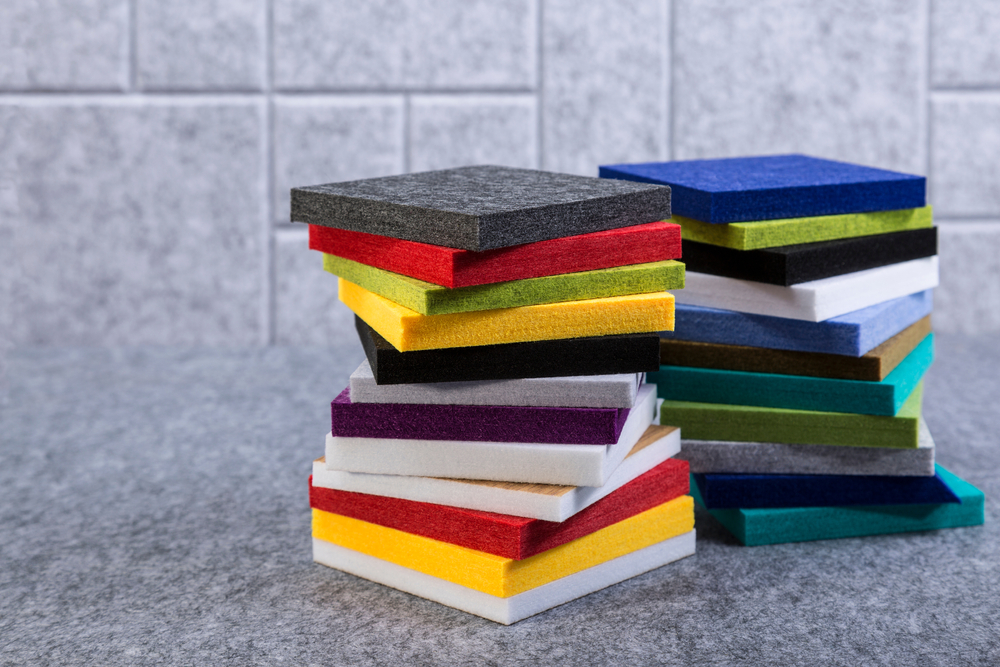3 Parts to an Acoustic Panel

An acoustic (or sound-absorbing) panel is one of the most common options for
improving sound quality in a room. They are used to mitigate noise by reducing the
reverberation and echo within a space. It is important to note that an acoustic panel
does not actually soundproof a room or block sound from entering a space. Let's take a
closer look at the parts that make up these sound-absorbing panels and how they
function.
Core
Acoustic panels come in many different shapes and sizes, from the standard wall panel,
to baffles, to clouds; however, no matter the shape, one thing they all have in common
is they all have a sound-absorbing core. The core of an acoustic panel is the most
important part. It's where the magic happens and where sound waves are dampened
and deadened to control reverberation. Existing sound is converted into heat,
reducing the sound waves’ ability to reflect back. While there are many different types
of material that can be used as the core of an acoustic panel, some of the most
common types are acoustical foam, cotton, fiberglass, and recycled polyester.
When selecting an acoustic panel, select a core with the highest NRC (noise reduction
coefficient). An NRC of 0 means the material absorbs no sound, and a rating of 1
means that the material absorbs almost all sound. A good rule of thumb is that a NRC of
0.8 is good, and a rating of 0.9 or higher is very effective. Let's take a second to look at
a few different sound panels with different core materials.
SONEX acoustic foam panels are made from Willtec acoustical foam and boast an
impressive NRC of 0.92. They are also Class-1 fire-resistant, making them a great
option for commercial buildings and businesses.
UltraQuiet Acoustic Panels have an NRC ranging from 0.85–1.15 and have an
environmentally friendly cotton core. The edge contributes to sound absorption thus increasing NRC above 1.0. Surprisingly, they also have a high fire rating,
making them a safe choice for businesses as well.
Whisperwave panels come in a wide variety of shapes, sizes, and NRC ratings. They
mostly have foam cores with a rating of 0.85 or higher. They are also fire-resistant and
are designed to look great in large spaces such as offices and lobbies.
When picking a sound-absorbing panel, be sure to target the amount and frequency of
sound you want to reduce. Not all panels are built the same, and some might work
better in certain environments. If you need help, feel free to give us a call or use this
handy
Acoustic Panel Calculator to figure out exactly what you need.
Fabric
The fabric around an acoustic panel is primarily for aesthetic purposes. If you are
placing large panels on your walls or have baffles hanging from the ceiling, you’ll want
them to look good and match your aesthetic. These fabrics are acoustically transparent,
meaning they allow sound to pass through them and right to the core of the panel.
Acoustically transparent fabrics for sound control come in a variety of different sizes and
colors. Guilford of Maine creates quality acoustical fabrics with a Class A fire rating,
making them perfect for businesses and homes. Get a cost-effective solution to your
sound-quality problems with stylish, modern designs.
Mounting Options
The final piece of an acoustic panel is the mounting option, i.e., how the panel is
directly mounted to the wall, ceiling, or suspended from the ceiling. One popular
option is a
fabric wall track system. These tracks allow you to easily and affordably
stretch fabrics across large quantities of acoustic panels, vastly changing the natural
acoustics in the room. They use large seamless swaths of fabric to provide excellent
coverage across large spaces, making them a great choice for gymnasiums, office
rooms, and bars. Best of all, the setup is simple, so you can DIY your own acoustical
setup in your home office or workplace.
For hanging baffles, you might want to use corkscrew hangers to ensure a tight fit that
won't come loose. One of the last things any business owner wants is for part of their
ceiling to fall on someone's head, and thankfully these hangers are designed to prevent
exactly that. We also carry Z-clips, rotofast fasteners, and impaling clips to ensure your
panels are affixed tightly to any surface and won’t come loose or fall off. These
fasteners are easy to install and perfect for any task, from tiny do-it-yourself projects to
massive installations.
Now that you have a better understanding of what makes an acoustic panel and how
they function, the next step is figuring out exactly what your project needs. Spend some
time to figure out if you want to use wall panels, ceiling hanging baffles, other forms of
sound control, or a mix of these options. Don’t forget to use our
Acoustic Panel Calculator, or give us a call at 866.768.6381. We're here to help find the sound solution
that’s right for you!
|
|
|

